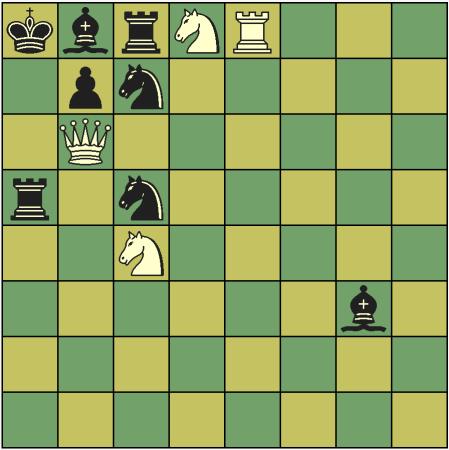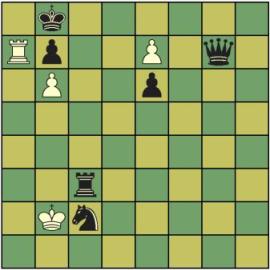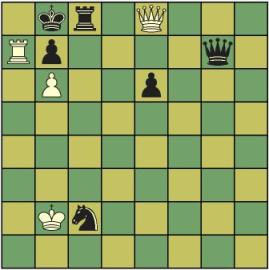SC - Chess
Introduction
A rule dropping in chess enriches games. Hostage chess is an excellent game with a dropping rule. Here we propose a game with one more possibility of dropping. We allow non-king pieces of the same color to capture each other. For example, if a white queen goes to the square a white knight locates, then the knight is captured and reserved beside a white player. From the next turn, the white knight can be dropped onto any empty square on the board.The name "SC-chess" comes from "self-capture", capturing own pieces stated above.
Setup
We use the ordinary initial arrangement of chess pieces on an ordinary chess board. Like Hostage chess, both sides of each player are assigned to rooms for reserve pieces, your right side is a prison for your opponent's pieces, and left side is an airfield for your pieces.Pieces
We use ordinary chess pieces.Rules
We adopt the following special rules besides the Orthodox Chess rules.1. (exchange) If you capture your opponent's piece, then put it in your prison. If you and your opponent have captured the same kind of pieces, then they are exchanged "immediately". When you exchange the pieces, put the piece from your prison into your opponent's airfield. It is done by you and your opponent simultaneously.
2. (self-capture) Your non-King pieces can capture not only your opponent's pieces but also your own pieces except a King (self-capture). Your King can capture only your opponent's pieces and not your own pieces. It is likely that non-king pieces can quarrel among friends. Self-captured your pieces are stored in your airfield.
3. (drop) In any turn, a piece in your airfield can be put (dropped) on any* empty square on the board instead of moving your piece on the board, which is considered as one turn. (* An exceptional rule exists for Pawns, below.)
4. (Pawn) A Pawn can not be dropped onto the 8th rank squares. But unlike Hostage chess, it can be dropped onto the 1st rank. A Pawn is always allowed to jump from the 2nd rank to the 4th rank irrespective of it was dropped or not.
5. (promotion) Pawn promotion is performed by exchange. Your Pawn is promoted to any of your pieces except a Pawn, King, and the pieces on the 8th rank. As soon as your Pawn reaches the 8th rank, it goes to the square or your airfield or your opponent's prison where the target piece lives in, and the target piece is dropped onto the square where the pawn located last. This exchange is done before the next turn starts.
6. (others) Castling can be done according to the Orthodox Chess rule. En passant also obeys the orthodox rule, but several notes follows. Your Pawn located on the 5th rank has ability to do en passant capture irrespective of it was dropped or not. The target Pawn is only your opponent's Pawn jumping from the 2nd rank to the 4th rank, not a dropped one directly onto the 4th rank.
The rule 1 is little bit different from Hostage chess, this is more simple. There is no possibility that a bishop and a knight are exchanged. [As a minor variation of rules, it is possible to adopt the same rule as in Hostage chess about the exchange of pieces.]
By those rules, the pieces on the board does not exceed the starting pieces, and there exist reserve pieces out of the board of both black and white, one color ready to use in the airfield, and another waiting for exchange in the prison.
Notes
It is important that a King is the most ordinary piece which never self-capture and of course never self-captured. A good taste and interest of checkmating a King as in Orthodox Chess are kept by this rule for the King. Indeed, if a King can self-capture, then there are no obstructions for it and it will always go as if it is alone.Self-capture gives you another strong method of attack and defence. Exchanging imprisoned pieces gives possibility to drop to both of players, while self-capture gives it to one side. However, it depends on the situation whether self-capture is good or bad for you, because you certainly get a piece to drop, but in many case, your total power on the board decreases temporary.
By the rule 2, the possibility of solving chess problems is little bit greater than the case of Hostage chess. There exist some arrangements where Hostage chess can not checkmate a King, but SC-chess can. Figure 1 is an example. Black has all the rest pieces as reserve ones, while White has no reserve pieces.

Figure 1
[SOLUTION] Nxb6 Ka7 Nxc8 Ka8 R*a7 Bxa7 Nb6 Bxb6 Q*b8 Kxb8 Nc6.
After Nxc8, exchanged Rooks, and then White has a Queen and Rook in the airfield. R*a7 means a Rook from the airfield is dropped onto a7.
There are many choices when you promote a Pawn: which piece to be, where it locates --- on the board, airfield, or prison. It is quite natural to choose the strongest piece in the prison for a promotion target, you can rescue an imprisoned piece. However, there exist some cases that you should promote a Pawn to an on-board piece. Figure 2a shows such a case that the White Pawn E7 should be promoted to the Rook A7, it causes an immediate checkmate (Figure2b). But if the Pawn is promoted to an imprisoned Queen, then the Black Rook C3 moves to C8 (Figure2c), and the White King is mated after several turns.

Figure 2a |

Figure 2b |

Figure 2c |
Related games
There exists a game named Recycle Chess, which allows self-capture and drop in Orthodox Chess. I was not aware of the game when I invented SC-chess. In this sense, SC-chess is a combination of Hostage chess and Recycle chess. In Recycle chess, promotion is not allowed (perhaps because it causes too many Queens), whereas Hostage chess and SC-chess cleared this problem regarding promotion as exchange. One more difference between Recycle chess and SC-chess is that, as stated in Notes, SC-chess does not allow a king to self-capture any pieces. The reason of that is also found in Notes.
Editor's note: this game was briefly named Exchess, but the name was changed to avoid confusion.
Written by Kazuto Asai.
WWW page created: February 20, 2004.
Last updated: March 5th, 2004.